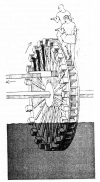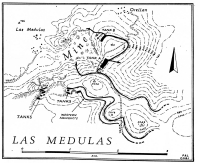


Pliny the Elder wrote about this site (NH ...): "What happens is far beyond the work of giants. The mountains are bored with corridors and galleries made by lamplight with a duration that is used to measure the shifts. For months, the miners cannot see the sunlight and many of them die inside the tunnels. This type of mine has been given the name of Ruina Montium."
Mining
Many aqueducts were built to supply water to industrial sites, such as gold mines, where the water was used to prospect for ore by hydraulic mining, and then crush and wash the ore to extract the gold. They usually consisted of an open channel dug into the ground, with a clay lining to prevent excessive loss of water and sometimes with wooden shuttering. They are often known as leats. However, they were built just as carefully as the masonry structures, but often at a higher gradient so as to deliver the greater volumes needed for mining operations.The large quantities of water supplied by the aqueducts were used for prospecting for ore-bodies by stripping away the overburden, and for working the ores in a method known as hushing. The technique was used in combination with fire-setting, which involved creating fires against the hard rock face to weaken the rock and so make removal much easier. These methods of mining survived into Medieval times until the widespread use of explosives. The water could also be used to wash ores, especially those of gold and tin, and probably to work simple machines such as ore-crushing hammers and water wheels.
The remains of such leats are visible today at sites like Dolaucothi in south-west Wales, and at Las Medulas in northwest Spain. These sites show multiple aqueducts, presumably because they were relatively short-lived and deteriorated rapidly. There are, for example, at least seven major leats at Las Medulas, and at least five at Dolaucothi feeding water from local rivers direct to the minehead. The palimpsest of such channels allows the mining sequence to be inferred.
From Wikipedia